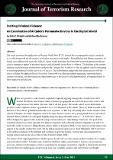Abstract
The study examines the application of the post-World War II U.S. Armed Forces propaganda analysis methods as a valid framework for the analysis of modern extremist social media. Using Jihadist and Islamic extremist, Al Qaida core, affiliate and associate (AQAA), digital media products, the framework examines persuasive devices used to attempt to appeal to potential recruits and ultimately incite them to violence. The findings of the content analysis extend previous examinations and provide a unique lens in which to view the appeals used in messaging to encourage potential violent actors in civil society. The examination categorizes tools of persuasion with the aim to validate the applicability of a historical framework in exploring modern messaging, informing future counter-narratives, and providing law enforcement cues in the analysis and determination of ongoing threats in their respective jurisdictions.
Citation
Wright, J., & Bachmann, M. (2015). Al Qaida’s persuasive devices in the digital world. Journal of Terrorism Research, 6(2), pp. 70-82.
Publication
Journal of Terrorism Research
Rights
This is an open access article published in Journal of Terrorism Research. This work is licensed under a Creative Commons Attribution 3.0 License (http://creativecommons.org/licenses/by/3.0/)
http://creativecommons.org/licenses/by/3.0/


